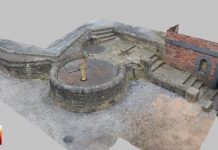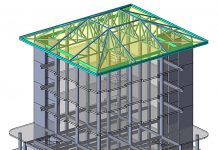Ian Chapman, Director of the National BIM Library, NBS sheds light on the demand, growth and benefits of BIM objects in the construction industry
It’s hard to believe that in less than one year from now the UK will have passed its 2016 BIM mandate deadline.
A lot has changed over the past five years, and there is plenty of momentum that will take us towards a digital construction industry. There is no doubt that awareness of BIM continues to grow, and both the client and supply sides of the construction industry are taking BIM seriously.
Demand for BIM objects from designers has gone through the roof, and the NBS National BIM Library is releasing more objects than ever before. In February 2015, NBS released over 1,200 BIM object files spanning 17 manufacturers and, as the findings of our recently published BIM for Manufacturers report demonstrate, the demand for objects is such that in the not too distant future, manufacturers without BIM objects will be as lost as those manufacturers without a website or pdf catalogue are today.
The help and leadership provided by the UK Government’s BIM Task Group has, without doubt, been an extremely successful approach. Other countries are in awe of how far we’ve come in a relatively short time.
The release of freely available, accessible-to-all standards has given the UK a big advantage over its overseas competitors. Standards are vital to all industries as they:
• Reduce time;
• Improve quality;
• Permit compatibility and integration;
• Improve value for money;
• Enable trade.
Their mere existence offers the purchaser a means of accepting or rejecting goods, on the basis of whether or not they comply with the standard.
How can you judge quality without a standard to make assessments against? This is a dilemma facing many when scouring the internet for BIM objects. There are more and more objects to choose from, but knowing which ones you can trust and which ones will have valuable information is not always obvious. Quality is essentially a measure of the extent to which an object fulfils its purpose. On this basis, it must therefore be possible to determine the quality of an object by comparing its inbuilt characteristics against a set of known requirements. If those characteristics meet all or most of the requirements, the object can be deemed ‘high quality’; and when objects meet few of the requirements, then ‘low quality’ is the label given.
NBS has set the standard for construction information for decades, and the need of the majority for both generic and manufacturers’ BIM objects led to the creation of the NBS BIM Object Standard.
Published in 2014, the NBS BIM Object Standard defines clear requirements against which all BIM objects can be assessed. The first of its kind globally, the Standard defines what constitutes a quality BIM object, and provides the foundations for a consistent approach that can be adopted by designers, manufacturers and all BIM content developers.
It is a standard that sets out essential requirements for BIM objects for use with Level 2 BIM. Not only is it vital reading for designers and manufacturers, but clients and project managers procuring buildings and digital assets can easily reference this standard, giving assurance that objects purchased are useful.
Developed in-house with feedback from industry and supported by all of the major BIM platforms, the Standard has been extremely well received. With over 6,000 downloads of the NBS BIM Object Standard since launch, it has become more popular than we had imagined, and a day rarely goes by without someone letting us know that they’re using it.
The recent BIM for Manufacturers survey has revealed the impact that the Standard has had on industry to date, with 18% using it in their business within a matter of months of its launch.
Feedback has been overwhelmingly positive, and as a result (and very much in keeping with NBS’s efforts to help digitise the construction industry), we’ve digitised the NBS BIM Object Standard so that it’s now available in an entirely online form. It’s accessible on any platform at any time.
Better still, we’ve authored comprehensive guidance to accompany the Standard, and the online version presents this guidance in context directly next to the clause information – in a very similar fashion to the comprehensive technical guidance included within NBS’s trusted specification products.
Use of a standard affords many advantages:
Assurance – the assurance the Standard brings to clients and project managers is significant. Clients need to improve their ability to procure data. Getting the right data about your built asset will yield benefits throughout the operational phase of the asset. By using and referencing the NBS BIM Object Standard, clients and project managers can be confident that the quality of BIM objects within their project models is suitable, and to a recognised standard.
Efficiency – designers are creating objects themselves, as there are not enough manufacturers’ objects in the market place. Operating in silos is not efficient for the UK construction economy. With the NBS BIM Object Standard, designers can create objects safe in the knowledge that they will be compatible with other objects to the same NBS standard. This will bring efficiency to the design process by enabling more meaningful information exchange, and ultimately lead to better designs and better buildings.
Quality – manufacturers have a big job to do. They have the challenge of creating objects and making them available at the right time in the right place; and all by 2016. This standard gives manufacturers who want to create objects themselves, a clear benchmark and a clear place to start. It provides knowledge and helps manufacturers focus on what matters. For any manufacturer, the NBS BIM Object Standard is an invaluable starting point, as well as a mark of quality.
Compatibility – just as we saw with batteries, nuts and bolts, USB connectors, plug sockets, and will see in the not-too-distant future with mobile phone chargers, standardisation brings compatibility. BIM objects need to work with each other – adopting a common standard benefits everyone. Combining doors from multiple manufacturers within a single project becomes possible when they all have a consistent underlying data structure – creating door schedules at the click of a button is possible with BIM.
NBS provides manufacturers with lots help when it comes to BIM, whether it be general advice, authoring BIM objects or certifying and checking BIM objects to ensure they meet the needs of the industry.
End users also benefit from regular updates from our customer service team, as was the case recently when all Revit and IFC manufacturer objects available through the NBS National BIM Library were updated to the NBS BIM Object Standard.
We also offer the NBS National BIM Library hosting and certification service, which gives construction project teams further assurance that the data in their models is compliant with the government’s level 2 BIM requirements.
The service enables manufacturers who choose not to have their BIM objects authored by NBS to still benefit from assessment by our industry-leading team of experts to ensure that they meet the NBS BIM Object Standard.
Once they have been certified as meeting the standard, these objects can then be hosted on the NBS National BIM Library and, in doing so, become part of the NBS BIM ecosystem, a unique combination of tools including NBS Create, NBS Plug-in and the NBS BIM Toolkit, which facilitate the flow of digital information throughout the construction process. If a manufacturer’s objects are not quite up to scratch, the NBS team will offer those authoring them advice on what they need to do to meet the standard.
The NBS Hosting and Certification service will also allow manufacturers to embed live BIM objects in their own website and other BIM object libraries, making the same BIM object more widely available and increasing the chance of it being found.
To find out more about having your BIM objects, authored, hosted and certified, call NBS on 0345 4569594 or via email at info@theNBS.com .
Ian Chapman
Director of the National BIM Library
NBS
Tel: 0345 456 9594
ian.chapman@thenbs.com
www.thenbs.com
http://uk.linkedin.com/in/ianchapmannbs













